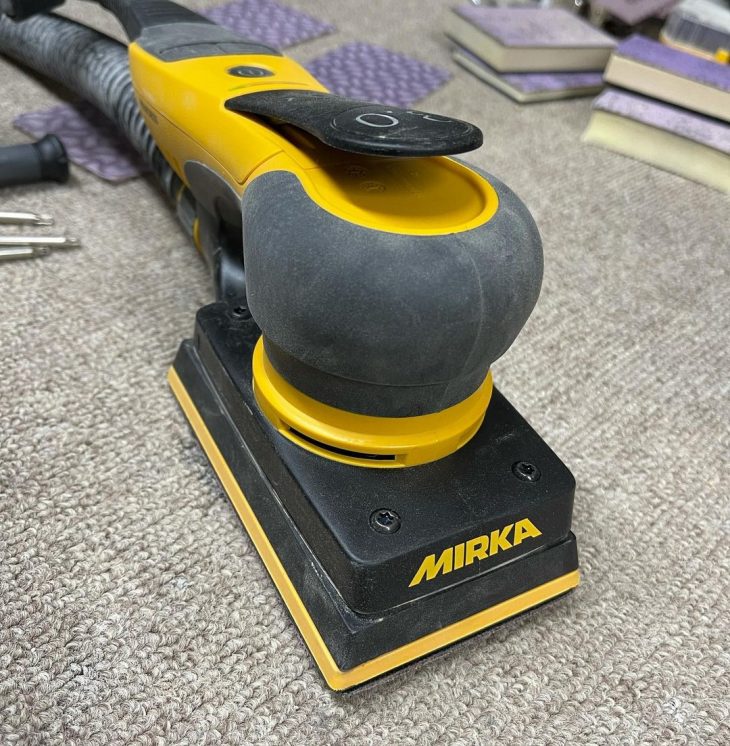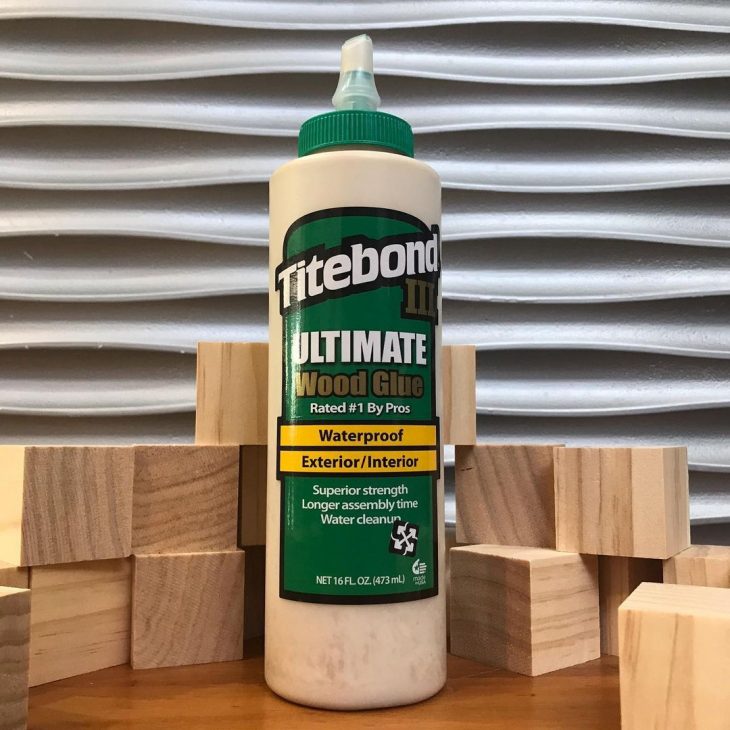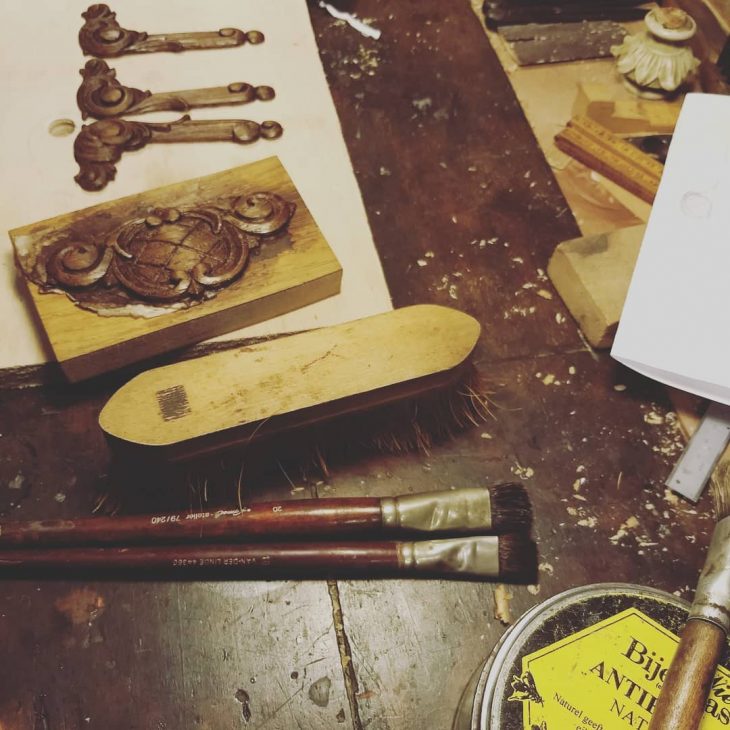Marquetry, Inlay and Intarsia are three distinct methods of decorating woodwork or furniture with different colors and types of wood or other materials. Marquetry is a decorative pattern or picture of contrasting woods done in veneers, which are subsequently attached to, and covering the groundwork. Inlay is inletting contrasting pieces of wood, veneer or other material such as tortoise shell, mother of pearl, ivory, brass or other metal into a solid wood groundwork that is part of the finished piece. Intarsia is inletting solid wood or other solid thicker material into other solid woods forming a mosaic pattern. The end result with all of these different methods actually produce similar appearing results of contrasting woods or other materials forming a decoration on the surface of a piece of furniture or woodwork. Many of the techniques are the same but different methods have different requirements and special tools. The French term for cabinetmaker is ébénist and those who specialize in marquetry are marqueteurs.
Marquetry is all done with veneers, geometric patterns, pictures, stringing and a myriad of other decorations made entirely of thin sheets of wood or veneer that is attached with hide glue to a stable groundwork of wood. The advantage of veneers is that rare, exotic and expensive and unstable woods such as crotches and burls can be used to cover the inexpensive groundwork forming the foundation of the work. The entire surface of the furniture or woodwork is covered with veneer and contrasting veneers are used to create patterns or pictures on the various surfaces. Marquetry can be cut by hand using a sharp knife, for production a scroll saw is used and the traditional tool that was originally used to make marquetry is a marquetry donkey see illustration below. This is a bench tool that the worker sits upon and uses their foot to control a vice that holds the work vertically. A saw with a very fine blade is suspended on a mechanism that keeps the saw blade perpendicular to the work while allowing it to move in a limited area. The work is rotated as necessary to keep the cut on the line and held secure with the foot vice. The saw stays in roughly the same place and cuts in one direction, it doesn’t turn, the work is turned. The work is always done with several pieces of veneers of different colors held together in a packet so all can be cut at once. A small strip of paper is edge glued around the packet of veneer to hold the pieces of veneer in place as it is being worked. A piece of ‘grease paper’, paper covered with a thin coat of lard is placed on the front of the packet of veneer to help lubricate the blade as it is cutting through the veneer. If the work has seven different colors then seven sheets of veneer are cut at once, producing seven different designs, all the same, and just different colors. By careful planning you can end up with the proper design, for instance if the backgrounds of the design are all the same color then additional sheets of the background veneer are added to the packet. The blades for this type of work are very fine jeweler’s saw blades that cut the veneer and leave a very fine kerf. When the work is done, the packet is separated and the appropriate pieces are assembled to form the pattern. These were usually glued to thin paper, pressed and allowed to dry. Once it is dry, the small kerfs between the pieces must be filled. This is usually done with filler similar to the material used to fill the pores or grain of wood. A neutral color is selected because of the different colors used in marquetry work. The filler is pushed down into the saw kerf to completely fill the voids. See Filling Grain for instructions on using this material. After the filler has dried and been sanded the finished design is then ready for use. Traditionally these were glued face down with the paper facing up, this allows the veneers to be glued directly to the groundwork and after drying the paper is scraped or sanded off. Additional filling might be required after the surface is smoothed. Remember that veneers in the nineteenth century and earlier were considerably thicker than those available today, so sanding and scraping is not a problem.
Marquetry reached perhaps its zenith was the work of André-Charles Boule a French cabinetmaker from the early 1700’s and was popular through the end of the nineteenth century. The term boule or buhl is used to describe his original use of brass and hawksbill tortoise shell to decorate furniture and woodwork, usually of ebony. The contrast of the black ebony, yellow brass and mottled reds and yellows of the hawksbill tortoise shell is striking. The shells were scraped to uniform thickness and cut out along with the brass to produce this beautiful work. The groundwork under the tortoise shell is sometimes prepared with a bright red base that shows through the translucent shells, sometimes the backside of the tortoise shell is gilt before it applies and this gold leaf adds a beautiful luster to the thin shell. I have had to repair a couple of pieces of boule and because of the mixture of materials, brass, shell, ebony and wood, swelling and expansion of the groundwork or the shell itself will cause buckling of the shell and the brass. Shrinkage causes the most damage and is the most common reason for deterioration of this work.
Inlay is the process of placing material, usually veneer or other thin material into a solid groundwork or matrix. The groundwork is also the finished material unlike marquetry where the groundwork is completely covered. The most common method of inlaying is stringing, placing long thin pieces of contrasting veneer along edges of the woodwork. Purfling is stringing used on musical instruments such as violins and cellos and composed of two layers of ebony sandwiching a layer of holly. This stringing is said to reinforce the delicate edge of the maple back and especially the spruce top. The purfling is also said to affect the tone of the instrument. There are un-purfled instruments that have good tone and similar splits on the tops and backs as those that have purfling. Holly (Ilex opaca) is a common inlay wood because it is the whitest wood in the world, boxwood (Buxus spp.), a creamy smooth dense grain wood is also a good choice for stringing and other inlays. Sycamore (Plantanus spp or Acer-pseudoplatanus) is a light color wood that is frequently died or stained in bright colors. A technique common to marquetry and inlay is the use of scorched wood, especially boxwood and sycamore. This involves dipping the pieces of veneer partially into hot sand that scorches the edge of the piece producing a gradual shading from the natural color of the wood to a dark brown at the very edge of the veneer. The piece is held just into the hot sand repeatedly removing and checking the progress of the burning. Hot sand is used because it is a dry heat and will usually not cause the piece of veneer that you have spent an hour making to ignite, do not use an open flame. When scorching veneers take into consideration that after they are scorched, they are just a little thinner than the un-scorched areas so you will need to scrape or sand to make all surfaces level prior to finishing. The scorching goes through the wood, so it can be sanded and most dyed veneers are colored completely through the wood fibers as well. Inlay can also include marquetry inlays with designs, patterns or pictures and this veneer picture is inlayed into the solid wood.
Unlike marquetry, inlay requires tools other than saws to place the inlay material into the woodwork. While many of the inlayed materials can be cut with a saw, cutting into the woodwork requires sharp knives, chisels, inlay gauges, and hand routers for bottoming the recess. For work like stringing a special cutter can be used to cut both sides of the slot and remove the material in between in one cut. The tool is like a scratch stock (See Scratch Stock) or slitting gauge and has multiple knives. The two outside scoring knives are sharpened to a round point with flat side on the outside and the bevel towards the center. Additional saw tooth cutters can be inserted between the two scoring knives for different width stringing inlay. These tools cut in both direction. The depth of the knives protruding below the beam determines the depth of cut. The bolt with the inlet nut holds the blades in their correct position. See illustration below. Without this special tool you can also make them with a sharp knife and a narrow chisel. Inlaying stringing can be done by clamping a straightedge in the correct place and the cut is made with a sharp knife to a uniform depth. Clamp the straightedge on the money side of the cut and do your cutting on the waste side, just in case the knife drifts. You can reduce drifting or following the grain by holding the knife at a higher angle with only the tip of the knife blade doing the cut. The more blade in the wood the greater the chance of the blade drifting and coming off the line. Re-clamp to the other side and repeat the process. A narrow chisel is then used to remove the waste between the two lines. A small hand router plane can also be used to clean up the bottom and provide a uniform depth recess. The bottom of the recess does not need to be perfect, but it should be relatively flat but not necessarily smooth, this roughness will act as a key or tooth for the glue. When making the recess for the inlay, the sides should be slightly angled outward, in other words it is just a hair wider at the top than at the bottom. The corresponding inlay should be ever so slightly undercut (wider at the top and just slightly narrower at the bottom) to form a corresponding angle to the recess. This insures that the top of the inlay will be tight in the surrounding wood producing a flawless inlay. It is possible to make your own stringing from veneer using a slitting or cutting gauge to safely and easily cut uniform width strips of veneer for inlay stringing.
Irregular shaped inlays need to be held in position to carefully cut the initial inletting layout cut. One way to secure the inlay is to use sharp pins placed around the object just at its edge to hold it in place. The pinholes will be in the cut so they will not show. As you come to the pin, just remove and continue the cut and replace the pin. Carefully cut around the shape and hold the knife at a slight angle away from the inlay material. Take care not to cut into the inlay material. This angle produces the angle cut that makes for tight inlays. The waste material within the lines is removed using chisels or a hand router plane or old woman’s tooth router. See Making and Using a Router. This will produce a uniform depth for the inlay that makes for smoother scraping and sanding. Irregularities can be scraped or sanded off but it is better if the inlay lays flat in the recess for better results. If you inlay a particular design often you should considering making a tin, brass or copper pattern to prevent cutting into the wood inlays. I go around after the first cut and using a very sharp chisel to carefully cut a V into the layout line on the waste side. This gives a positive edge or shoulder to work up against so when you are using a chisel or router it will not chip out the surrounding wood. It is a good idea to sweep up the shop prior to doing inlay work. If you do chip your work, a clean shop floor is easier to find that invariable chip that can easily be glued back into its place. I like to key or tooth the backside of the inlay to provide more surface area for glue. I also use a flat caul, large enough to cover the inlay. This insures that the inlay will be as flat as possible and just proud of the surrounding surface
Wire Inlay is a type of decoration with what appears to be a thin wire, usually silver wire inlayed into the solid materials. It is actually a small ribbon of silver that is inlet edgewise and only the very edge of the ribbon is exposed, appearing like wire. This is done with small hand made chisels. I made my set from an old hacksaw blade. Broken into 2-inch lengths and shaped and sharpened on the end these tools make the recess or cut for the wire ribbon. Sharpened with a double bevel, some are straight and others have a curved filed into their cutting edge. They are small chisels that form a slot in the wood to receive the wire inlay. After carefully laying out and marking the surface the chisels are driven straight into the wood to a uniform depth of less than 1/8th inch. I have small shoulders ground on both sides of the chisels that are the same as the required depth and provide a visual depth stop. The slot is made by repeatedly pounding the small chisel squarely into the wood, using a straight chisel for straight work and curved chisels for curves. Smaller tighter curves are done with curved, narrow chisels always held perpendicular to the surface being inlayed. Once all of the cuts are made, the silver ribbon is formed to shape and cut to length. The ribbon should be a uniform width and its thickness will be how wide the inlay will be. The width should correspond to the depth of cut that the chisel will make. The wide sides of the ribbon are roughened with a file or sandpaper and the surface etched with a clove of garlic. The garlic allows the metal to be glued with hide glue. Hide glue is placed on the metal and it is carefully driven into the slots created by the chisels. Don’t put glue in the slot as it is just compressed wood, no wood was removed, and will swell shut if too much glue gets to the wood fibers. I carefully pound the ribbon into the wood until it just is just proud of the surface and allow the glue to dry. The moisture in the hide glue swells the wood fibers tight around the roughened wire ribbon to securely hold in place. I wipe it down with a wet rag to clean off the excess glue and the moisture also swells the wood making the inlay tight. Once it is completely dry, the wire can be sanded or scraped smooth. Yes you can use a cabinet scraper to smooth off the soft metal. You can also file, I recommend that you draw file to produce the smoothest surface on the wire inlay. The wire will show scratches from sanding, so you will have to sand the metal with much finer sandpaper. Also remember the metal is harder than the wood and it is sometimes difficult to get both materials to the same level and degree of finish. Horsetails or scouring rushes (Equisetum spp.) can also be used to smooth and polish the wire flush to the surface. I also burnish the wire with a hard metal burnisher to a mirror finish after it is smoothed level to the surrounding wood.
Intarsia is a method of decoration where larger, usually thicker pieces of wood are combined to form a picture, pattern or design in a mosaic pattern. Intarsia always has textures with some of the material protruding above or recessed below the surrounding surfaces giving a three-dimensional look. If it goes below the surface it is like intaglio carving, if it is above the surface is like cameo carving.
Tunbridge ware is a unique method of using wood for decoration. It involves small squares of end grain used to make a mosaic pattern on small pieces of furniture and woodwork. Pieces as small as 1/16th inch square and about the same length are arranged in patterns to form decorations and even pictures on small boxes and other decorative objects. This is accomplished by gluing 1/16th inch square pieces of veneer of different color together in long lengths. After drying these bundles or patterns are cut to the desired thickness and glued to the groundwork. One bundle of veneer pieces 12 inches long and ½ inch square can yield 90 pieces making 45 square inches of decorative material. That is over 5700 individual pieces of end grain veneer. While this looks complicated the process is quite simple. This is a popular material for rosettes surrounding sound holes on guitars.




Recent Comments